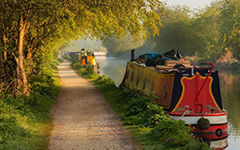British Canals History
The British canal system of water transport played a vital role in the United Kingdom's Industrial Revolution at a time when roads were only just emerging from the medieval mud and long trains of packhorses were the only means of "mass" transit by road of raw materials and finished products. (It was no accident that amongst the first canal promoters were the pottery manufacturers of Staffordshire.) The UK was the first country to develop a nationwide canal network.
 The canal system dates to Roman Britain, but was largely used for irrigation or to link rivers. The navigable water network in the British Isles grew as the demand for industrial transport increased. It grew rapidly at first, and became an almost completely connected network covering the South, Midlands, and parts of the North of England and Wales. There were canals in Scotland, but they were not connected to the English canals or, generally, to each other (the main exception being the Monkland Canal, the Union Canal and the Forth and Clyde Canal which connected the River Clyde and Glasgow to the River Forth and Edinburgh). As building techniques improved, older canals were improved by straightening, embankments, cuttings, tunnels, aqueducts, inclined planes, and boat lifts, which together snipped many miles and locks, and therefore hours and cost, from journeys. However, there was often fierce opposition to the building.
The canal system dates to Roman Britain, but was largely used for irrigation or to link rivers. The navigable water network in the British Isles grew as the demand for industrial transport increased. It grew rapidly at first, and became an almost completely connected network covering the South, Midlands, and parts of the North of England and Wales. There were canals in Scotland, but they were not connected to the English canals or, generally, to each other (the main exception being the Monkland Canal, the Union Canal and the Forth and Clyde Canal which connected the River Clyde and Glasgow to the River Forth and Edinburgh). As building techniques improved, older canals were improved by straightening, embankments, cuttings, tunnels, aqueducts, inclined planes, and boat lifts, which together snipped many miles and locks, and therefore hours and cost, from journeys. However, there was often fierce opposition to the building.
The modern canal network came into being because the Industrial Revolution demanded an economic and reliable way to transport goods and commodities in large quantities. Some 29 river navigation improvements took place in the 16th and 17th centuries starting with the Thames locks and the River Wey Navigation. The biggest growth was in the so-called "narrow" canals which extended water transport to the emerging industrial areas of the Staffordshire potteries and Birmingham as well as a network of canals joining Yorkshire and Lancashire and extending to London.
The 19th century saw some major new canals such as the Caledonian Canal and the Manchester Ship Canal. By the second half of the 19th century, many canals were increasingly becoming owned by railway companies or competing with them, and many were in decline, with decreases in mile-ton charges to try to remain competitive. After this, the less successful canals (particularly narrow-locked canals, whose boats could only carry about thirty tons) failed quickly. More details
 The canal system dates to Roman Britain, but was largely used for irrigation or to link rivers. The navigable water network in the British Isles grew as the demand for industrial transport increased. It grew rapidly at first, and became an almost completely connected network covering the South, Midlands, and parts of the North of England and Wales. There were canals in Scotland, but they were not connected to the English canals or, generally, to each other (the main exception being the Monkland Canal, the Union Canal and the Forth and Clyde Canal which connected the River Clyde and Glasgow to the River Forth and Edinburgh). As building techniques improved, older canals were improved by straightening, embankments, cuttings, tunnels, aqueducts, inclined planes, and boat lifts, which together snipped many miles and locks, and therefore hours and cost, from journeys. However, there was often fierce opposition to the building.
The canal system dates to Roman Britain, but was largely used for irrigation or to link rivers. The navigable water network in the British Isles grew as the demand for industrial transport increased. It grew rapidly at first, and became an almost completely connected network covering the South, Midlands, and parts of the North of England and Wales. There were canals in Scotland, but they were not connected to the English canals or, generally, to each other (the main exception being the Monkland Canal, the Union Canal and the Forth and Clyde Canal which connected the River Clyde and Glasgow to the River Forth and Edinburgh). As building techniques improved, older canals were improved by straightening, embankments, cuttings, tunnels, aqueducts, inclined planes, and boat lifts, which together snipped many miles and locks, and therefore hours and cost, from journeys. However, there was often fierce opposition to the building.The modern canal network came into being because the Industrial Revolution demanded an economic and reliable way to transport goods and commodities in large quantities. Some 29 river navigation improvements took place in the 16th and 17th centuries starting with the Thames locks and the River Wey Navigation. The biggest growth was in the so-called "narrow" canals which extended water transport to the emerging industrial areas of the Staffordshire potteries and Birmingham as well as a network of canals joining Yorkshire and Lancashire and extending to London.
The 19th century saw some major new canals such as the Caledonian Canal and the Manchester Ship Canal. By the second half of the 19th century, many canals were increasingly becoming owned by railway companies or competing with them, and many were in decline, with decreases in mile-ton charges to try to remain competitive. After this, the less successful canals (particularly narrow-locked canals, whose boats could only carry about thirty tons) failed quickly. More details
